As the pandemic roared through India, I wondered when tourists like me would be able to return to a country so central to the traveller’s imagination. When we did return, would it show the scars of the hideous death toll and extreme burden of suffering? Would we feel safe? Finally, nearly three years since I first wondered this, I went to find out. I flew not long after India relaxed all Covid paperwork late last year. A sadistically bureaucratic nation at the best of times, India had scrapped British e-Visas in retaliation for something that no one can quite work out, making the visa application process somewhat Kafka-esque. The e-Visa has, thankfully, since returned. It is a good time to return: prices can be quite reasonable on the layover flights a day from London to Delhi and Mumbai, plus direct hops to Bengaluru, Chennai and Hyderabad.
I passed a whorl of nuzzling pugs on chairs in a verdant pen and then arrived on the terrace
Having lost my traveller’s courage somewhat since Covid – and got older – this was no time for roughing it: my re-entry would have to be as well-managed and delightful as possible, the sometimes tricky bits of India smartly ironed out. Luckily, if you know where to go and are willing to spend a bit of money, this can be done almost completely. And if you don’t have much time – I had a week-odd in which to soak up what sun and culture I could – then you have to be realistic about how much of the country to see, while being open to a couple of low-cost domestic hops. I landed in Mumbai, flew to Indore in the middle West, then whizzed to Rajasthan for a few days in and around Jaipur before flying back to London from Mumbai.
Part One: Ahilya Fort, Maheshwar, Madhya Pradesh
My first stop was always going to be Ahilya Fort. I had yearned for this spot, where I had been just before the pandemic struck, and which I had hung on to as a beacon in the imagination in the years when Asia seemed a land never to be reached again. I hoped Ahilya would be the template for the second half of the trip: based around exceptionally-run, impeccably decorated, heritage-infused hotels that are less like hotels and more like the architectural passions of owners past and present.
I stepped, bleary, from Indore airport straight into an electric SUV, and was driven through a just-waking, colourful Indore, now India’s ‘cleanest city’ (and it looked clean, almost spookily so), into the hilly passes I had looked forward to seeing again as the morning mist lifted. We crawled through the hilltop Jam Gate, built by Maharani Ahilyabai Holkar – whose descendent Richard Holkar still lives in and runs Ahilya Fort – to connect Maheshwar to Indore. ‘Morning time is monkey time,’ said the driver, and though I peered into the greenery of the valley, no monkeys. It was beautiful and exciting anyway, just to be there.
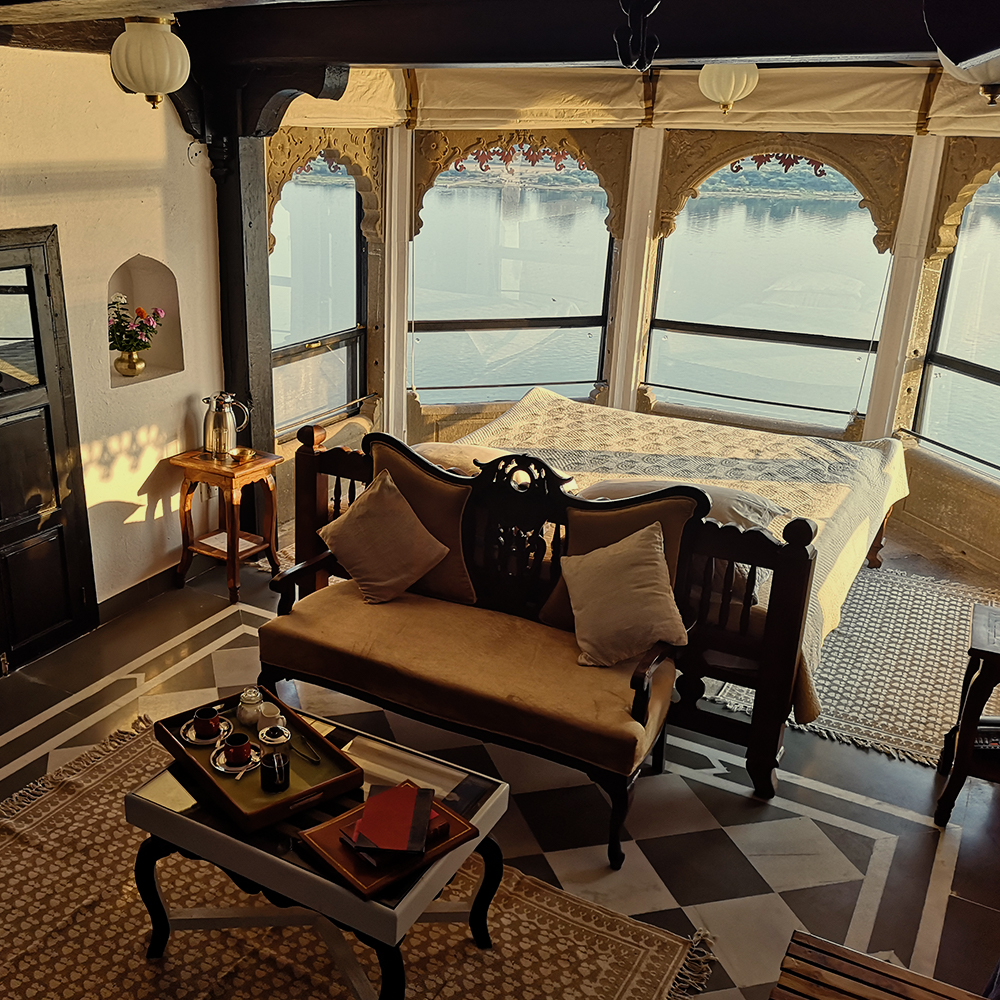
Arriving at Ahilya Fort is ideally done on more sleep than was in my tank, for there is much to take in. After a steep incline on narrow streets through Maheshwar – past piles of vegetables, drinks and textiles vendors, and shrines – the car nudged into a compound whose loose perimeter includes a whitewashed weaving factory with looms operated by local craftspeople, who exports saris for fashion houses throughout the world, and a temple where twice-daily rituals in honour of Queen Ahilyabai and the sacred Narmada river below take place. Dividing the fort proper from the public area of the temple, its shops and the bustle of the looms, is the kind of dark wooden door controlled by quiet guards that I have only ever seen in India, of imposingly martial depth and weight.
Inside, paradise awaits. I passed a whorl of nuzzling pugs on chairs in a verdant pen and then arrived on the terrace, canopied in white and pink flowers with blossoms on every wall. It’s here that I passed many hours with a book and cup after cup of masala tea, listening to the sound of the hubbub on the ghats far below, where swimmers cool off noisily throughout the day and boats putter out to the temple in the middle of the river, known as ‘the centre of the universe’. It’s here that breakfast, which includes home-made bread, exotic home-made jams inspired partly by Holkar’s residence in Paris, punchy poha (a spiced rice dish) and masala-streaked Mehashwari omelette, is served, as well as afternoon tea with lavender shortbread. Come evening, as the sun sets on the Narmada’s far bank, there are drinks – a remarkable array of non-alcoholic cocktails (booze is harder to come by, though by no means impossible, in Modi’s India) which come with a parade of savoury bites cooked continuously on a fire at the back of the terrace.
The grounds, and the rooms, are not flashy or particularly opulent but they are exquisite; unique, creaking with history, entirely without gleam or glitz. There are no TVs, but there are one-off centuries-old chaise longues, cannons, bronzes, old photographs and a small shrine room between the terrace and the inner courtyard. It all reflects the heritage and taste of Holkar – who remains a princely but convivial presence half the year.
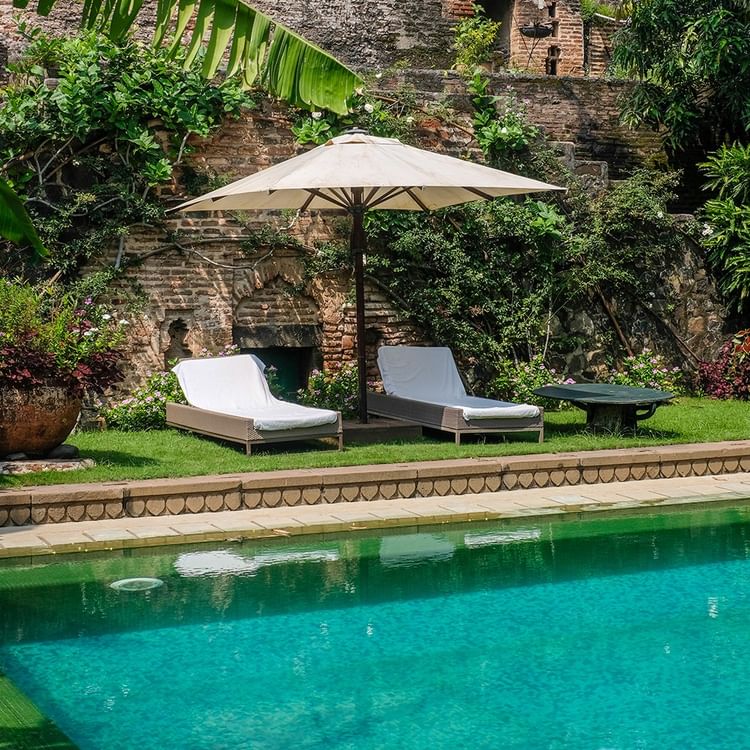
For those after sheer relaxation, the swimming pool is one of loveliest in the land: a riot of popping colour consisting of a large, cold aquamarine rectangle bounded at one end by the fort’s outermost walls with turrets, and by the lush kitchen garden on the other; flowers, low-hanging leaves and little recessed enclaves for elegant repose between meals are also inviting. Nearby is a pétanque court for more amusement and down steep stairs is a sunken outdoor yoga area and a small room for massage; simple but wonderful mostly local-style massages of body, head and foot – about £30 per hour.
Food is the organising thread running through any stay at Ahilya, and one of its most exquisite aspects, with many ingredients sourced from the fort’s own garden. Dinner and breakfast are communal, and there are always interesting guests, with the ratio of prosperous Indians to Europeans growing as foreigners have been wary of travel. I met some Indian academics and business owners, who had been glued to a long-running documentary about Richard’s ancestor Ahilyabai Holkar, as well as a famous English historian and solicitor turned portrait photographer to the stars. Dinner was a thali, but it was lunch that delighted most: think chilled pea soup, river fish croquettes, onion tart, sweet corn cakes, salad with flowers and spiced Kashmiri cheese followed by banana upside-down cake.
For those eager for action, there is much to see in the enormous and intricate temple halfway down the steps to the river, the weaving workshop and stores, and Ahilya’s own temple – further afield, there is also a day trip to Mandu, a magnificent ancient city.
Part Two: Anopura, Jaipur
My next stop was another sophisticated home. As Richard Holkar had stayed entirely at his fort during Covid, so local industrialist Aditya Baheti – a young, handsome patriarch – had dug in at his passion project Anopura with his wife and children. He was there during my stay, eagerly, quietly observing every detail; cerebral and glamorous as he was punctilious.
Anopura is an hour outside Jaipur in the ‘jungle’ – the atmospheric, hilly brush that rolls on and on in which lurks a small number of leopards and even more elusive tigers. I befriended a serious Italian zoologist on a research trip studying leopard sound signatures; she was great company on one of the long evening drives in the jeep, along with Piyush, the animal-loving manager, to find the spotted cats. We just missed one, but we saw plenty of ‘blue’ bulls, part of the antelope family, and interesting birds. In the absence of leopards, I was very happy with beers and puffed rice in a little gazebo facing the sunset.
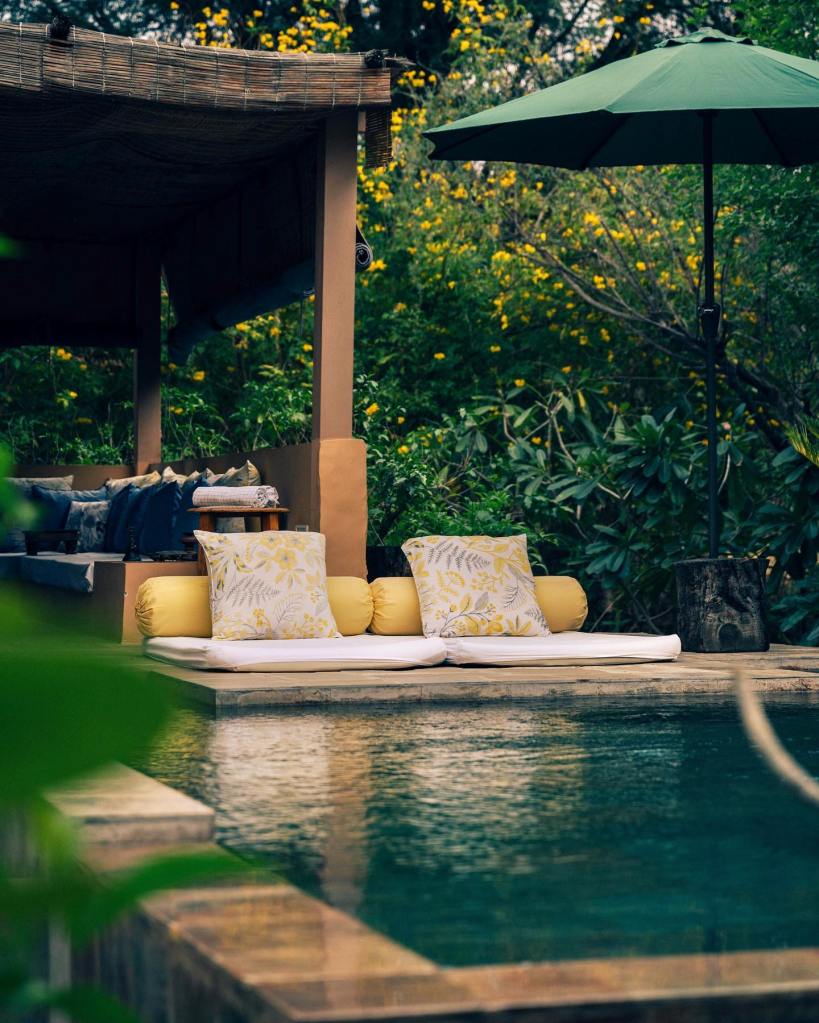
Anopura has no central area; it is all villas. My room included a big bedroom, quite simply furnished, and a bathroom of the same size, with a tub and shower. The best bit, though, was my slate-bottomed plunge pool and cosy little area around a low table, with books and cushions, and another table for intimate dinners. I loved having dinner here on my own, reading, drinking wine, and retiring early to bed. By day, as nobody was in the impressive central villa, I made use of its large, dazzling grey-bottomed pool, with views of verdant hills and the busy movement of peacocks and other colourful birds in the dense, humming trees. This large villa, which sleeps a couple of families, has in its indoor sitting room a cabinet of treasures retrieved by Baheti from far-flung corners of the world.
The Samode is more like a wonderful, bohemian museum than a hotel
One afternoon, I was taken to the Anopura farm, which includes a large vegetable garden as well as animals. The whole outfit employs and works with local villagers and artisans, who are elegant, skilled and knowledgeable. I encountered a team of them on the farm where, after meeting beautiful calves and baby camels, I was served a meal that included round, glistening balls of spiced bread that had been slow-cooked in a pile of hot ashy sand by a man in a white robe; the soft, nutty chapatis cooked over fire by a pink-sari-wearing lady were also perfect.
As at Ahilya, the service here is almost telepathic; ubiquitous and instant without ever feeling intrusive. After hours reading in the dusky sunshine, detailed zoological explorations, and wonderful meals, I was sad to leave, but ready to finish the trip in Jaipur itself.
Part three: Samode Haveli, Jaipur
If you are keen to experience the big jewel of Rajasthan in full splendour then you ought to stay in the 300-year-old Samode Haveli (haveli means mansion) and ideally in the room I snagged, the Sheesh Mahal, full of floor-to-ceiling glasswork and just about affordable as a special treat at around £400 for a night. It’s dark inside, but you’ll never see anything else like it. Divided up by vaulted arches covered from top to bottom in mosaics of the most fantastic beauty, the bed looks up to a ceiling of faded frescoes that put Renaissance Italy to shame. At night, I would lie awake with the light on, gazing at the optical splendour of the layered double archways, took selfies in the mirror framed in infinitely-refracting tiny mirrors, and sat in a jacuzzi bath trying to peer out sliver-like windows.
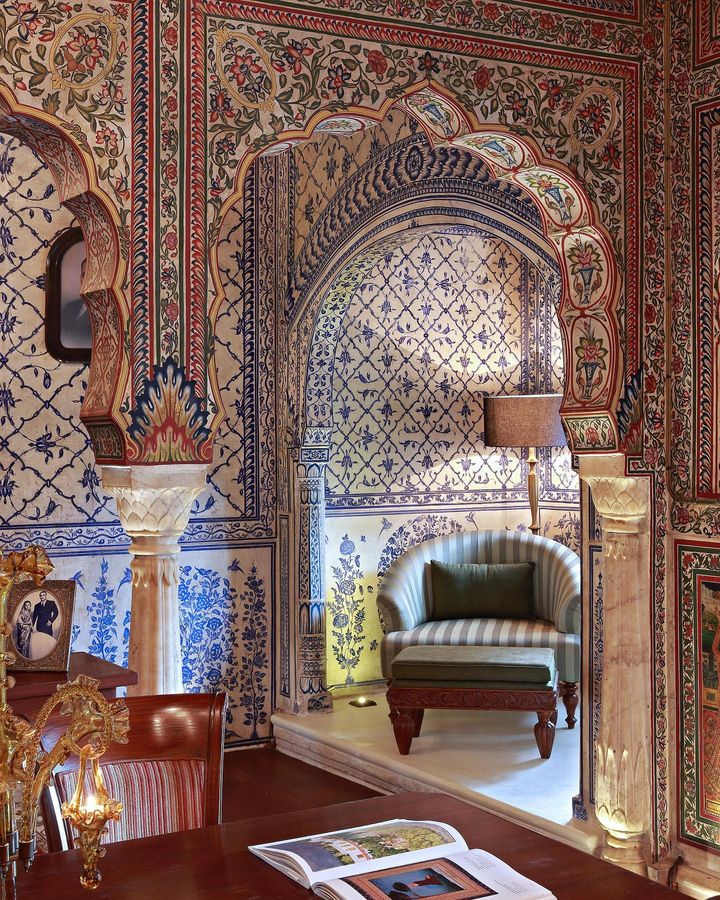
The Samode is more like a wonderful, bohemian museum than a hotel. Outside the room, its old yellow courtyard surrounded by airy, open sitting rooms full of Raj-era photographs, splendid pieces of furniture and walls of ruby, pale blue and yellow. You can lose yourself wandering through the haveli’s many layers, dreamily weaving between a mahogany bar, a sitting room full of fine Rajasthani objects, a light-spangled terrace, and a history-oozing dining room and bar, straight out of a Pall Mall club, only with Indian portraiture. Sunset cocktails should be taken on the rooftop, which offers excellent, somewhat unusual views of the city.
All the big hitters (Amber Fort, Pink Palace, City Palace and more) are near, easily attainable by tuk-tuk, Uber or private car which can be arranged by the hotel, and there are some fabulous textile shops a stone’s throw from the Samode. But you don’t strictly need to leave the gates of this particular mansion for a heady Jaipur experience.
Ahilya Fort, www.hilyafort.com, rooms from around £350 per night, all food included
Anopura, www.anopura.com, villas from £350 per night
Haveili Samode, www.samode.com/samodehaveli, rooms from £100

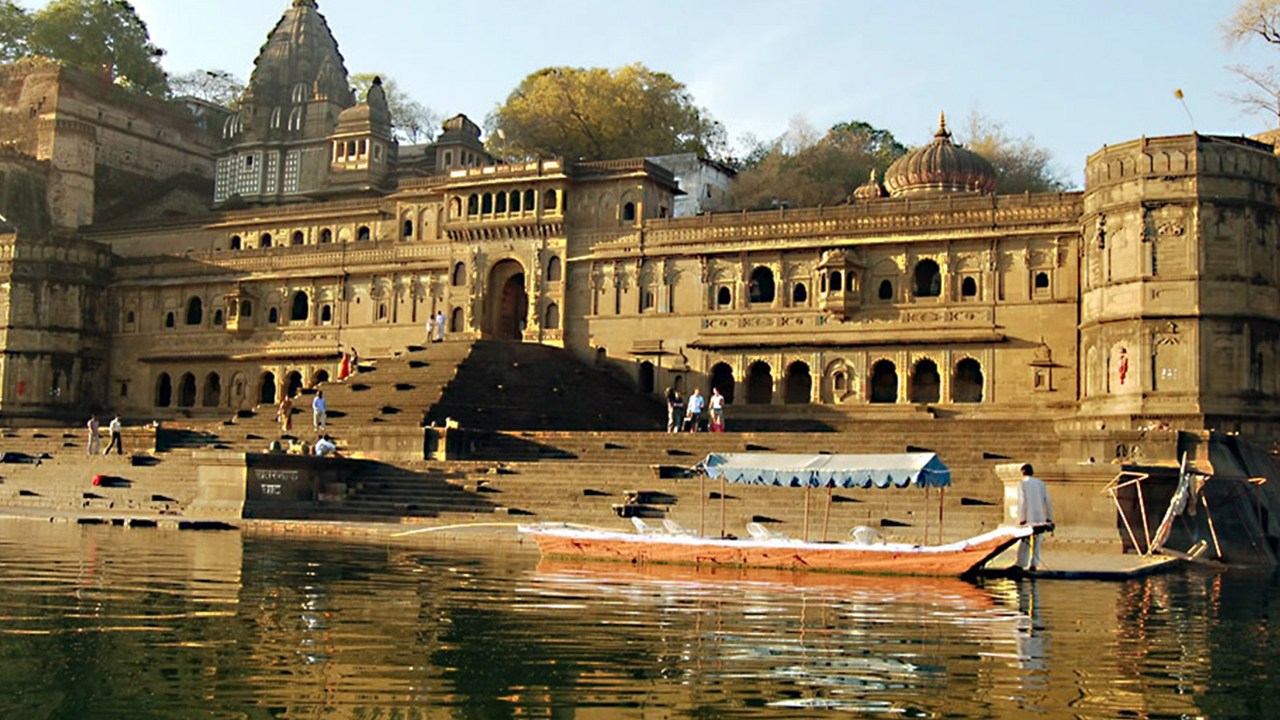





Comments